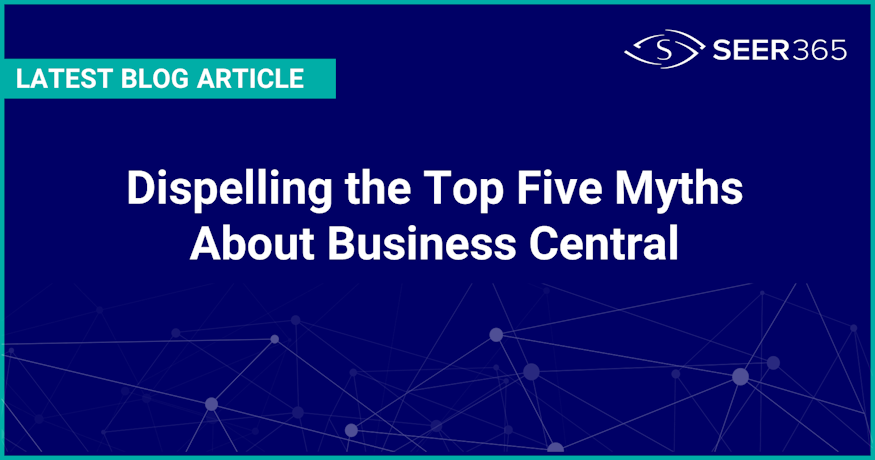Dispelling the Top Five Myths About Business Central

When organisations are looking at a new ERP solution, Dynamics 365 Business Central (BC), is often evaluated alongside Microsoft’s other ERP offering, Dynamics 365 Finance and Supply Chain Management (F&SCM), with various decision factors coming into play. Selecting the right ERP solution is critical for meeting your future business needs. Unfortunately, Business Central is sometimes unfairly overlooked due to misconceptions that it lacks the advanced capabilities of its Microsoft counterpart.
In the article below, Emma Wright, Director of Product Management at Seer 365, dispels the top five myths surrounding Business Central. So, whether you’re an organisation weighing up your future ERP solution options, or you work for a Microsoft partner implementing either of Microsoft’s ERP offerings, we would encourage you to read on.
Over the years, I have worked with several partners that sell and implement both Microsoft’s Business Central and Finance and Supply Chain Management (F&SCM) ERP solutions. As a Business Central specialist, I have often found myself defending its capabilities when it is compared against its Microsoft brother.
Many professionals with a F&SCM background tend to underestimate Business Central. In this article, I will address some of the most common misconceptions and myths about the solution that I have encountered over my 20+ years in the industry.
Business Central Myths:
1. It’s not scalable.
What does scalability really mean? The volume of data a system can handle, its transactional processing capacity or number of users? Let me address the first two of those three measures. Number of users is addressed in Myth 2.
When it comes to data volume and transaction processing, how does Business Central handle them? Dynamics 365 Business Central now features advanced auto-scaling and load balancing – something that wasn’t possible five years ago. While concerns about scalability may have been valid in the past, these are no longer a concern today. Auto-scaling and load balancing distribute workloads across multiple virtual machines, adding capacity as needed. Microsoft has provided real-world, anonymous examples of customers processing large volumes of transactions using Business Central, including 4,000 sales orders per hour with a total of approximately 150,000 sales lines-handled seamlessly. This is not a maximum, the system can handle even more. Regarding data, some customers have databases reaching as much as 1TB, though most are typically around or under the 100GB mark. The largest databases often belong to customers migrating from an on-premises version of Dynamics NAV or Dynamics BC.
2. We have hundreds of users. We need Dynamics 365 Finance and Supply Chain Management
There is often an assumption that Business Central is only suitable for small to mid-sized businesses and that a high user count requires Dynamics 365 F&SCM. However, Business Central’s auto-scaling and load balancing ensure it can handle large user volumes with ease. Microsoft reports that several Business Central customers have over 1,000 users, with thousands of companies operating with well over 100 users. While most customers still have around 20 users or fewer, there is a shift to larger numbers as confidence in Business Central’s scalability continues to grow.
3. We operate globally. We need Dynamics 365 Finance and Supply Chain Management
Business Central offers multiple localisations as does F&SCM, both products have Microsoft led and Partner led localisations. The Partner led localisations make a direct comparison of the total coverage of supported countries tricky. As of May 2025, Microsoft list 24 Microsoft led localisations, and 151 Partner led localisations for Business Central, totalling support in 175 countries. For F&SCM Microsoft list 54 Microsoft led supported countries, no specific list of Partner led localisations, and an explanation that the Globalisation studio means that it is possible to operate F&SCM in over 200 countries and regions. If we take these numbers we end up with Business Central at 175, and F&SCM at approximately 200 countries that are supported.
The need for F&SCM as opposed to Business Central really depends on the specific countries to be included and the functionality required.
For global operations, key functionality typically required includes intercompany trading, consolidation, and elimination processes. While Business Central does offer these features, F&SCM provides a much more automated experience. For example, eliminating intercompany transactions from consolidated accounts is a manual process within Business Central but is more automated in F&SCM.
4. Business Central does not support multiple companies
You might be surprised to hear this myth, but I have encountered it. Historically, NAV and BC have always allowed unlimited companies. However, in 2023 Microsoft did introduce a limit of 300 companies per environment for Dynamics 365 Business Central Online. This does not mean an absolute cap – if you exceed 300, you simply need to distribute companies across multiple environments.
5. We are a manufacturing business. We need Finance and Supply Chain Management
The right choice of Microsoft ERP solution depends on the type of manufacturing that you do, and whether you are open to using add-on solutions, known as ISV (Independent Software Vendor) solutions, to fill the gaps in Business Central’s core functionality. There are over 800 ISV solutions available for Business Central via Microsoft AppSource, specifically for meeting the needs of manufacturers.
Having worked extensively with NAV/BC in manufacturing, particularly in the fresh produce sector, I know first-hand that excellent ISV solutions exist that greatly enhance Business Central’s core manufacturing capabilities. Alongside this Microsoft are currently focussing on improving the standard Manufacturing functionality in Business Central.
Dynamics 365 F&SCM, provides more advanced, inbuilt manufacturing functionality, which is particularly useful for process manufacturers, for example. Specifically, this would be a challenge for out-of-the-box Business Central, however using an ISV solution, it can support batch production functionality. Ultimately, business size and budget will likely be the deciding factor as to whether a manufacturer goes down the Business Central or Finance and Supply Chain Management route.
Choosing the right solution is rarely an unbiased decision – most people will have their ‘favourite’ for a variety of reasons – some not necessarily the right ones. Whether you work for a company considering a new ERP solution or for a Dynamics 365 implementation partner or, like me, you have a deep-rooted affinity for one of the Microsoft solutions (for me, that’s Business Central), it’s important to set personal preferences aside when evaluating options.
If you are looking for an unbiased, data-driven comparison of Business Central versus Finance and Supply Chain Management, our GYDE365-Discover application can provide you with an easy way to capture your business requirements and generate a detailed fit/gap analysis and reliable project estimates.
Article originally appeared at Seer365.com
Contact us today at Pelorus Technology to elevate your business operations with our expert Microsoft Dynamics 365 solutions and Services. As a Global Microsoft Partner, we are committed to streamlining your processes and delivering top-tier services tailored to your needs. Let’s get started on your transformation journey!









